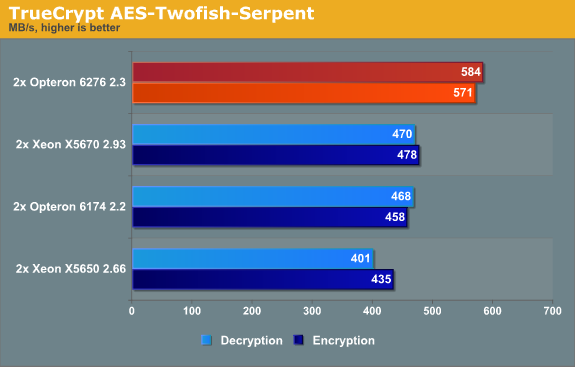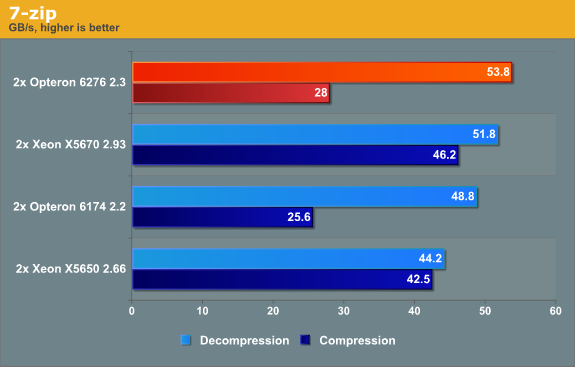Bulldozer for Servers: Testing AMD's "Interlagos" Opteron 6200 Series
by Johan De Gelas on November 15, 2011 5:09 PM ESTTrueCrypt 7.1 Benchmark
TrueCrypt is a software application used for on-the-fly encryption (OTFE). It is free, open source and offers full AES-NI support. The application also features a built-in encryption benchmark that we can use to measure CPU performance. First we test with the AES algorithm (256-bit key, symmetric).

You can compare those numbers directly with Anand's benchmark here. The Core i7-2600K at 3.4GHz delivers 3.4GB/s and the AMD FX-8150 at 3.6GHz about the same 3.3GB/s. We get about 2.3 times the performance here with four times as many "cores", but at 2.3GHz instead of 3.6GHz.
We also test with the heaviest combination of the cascaded algorithms available: Serpent-Twofish-AES.

The combination benchmark is limited by the slowest algorithms: twofish and serpent. The huge advantage that the architectures (Opteron "Bulldozer" and Xeon "Westmere") which support AES-NI had has evaporated: the Opteron 6174 keeps up with the best Xeons. The Opteron 6276 can leverage its higher threadcount as this benchmark scales extremely well.
It is good to realize that these benchmarks are not real-world but rather synthetic. It would be better to test a website that does some encrypting in the background or a fileserver with encrypted partitions. In that case the encryption software is only a small part of the total code being run. A large performance (dis)advantage might translate into a much smaller performance (dis)advantage in that real-world situation.
For example, eight times faster encryption resulted in a website with 23% higher throughput and a 40% faster encrypted file (see here). The advantage that the Xeon had in the first benchmark will not be noticeable, and the Opteron's 24% higher performance will translate into a few percentage points. But this is a benchmark where AMD's efforts to get a 16 integer cores inside a 115W TDP pay off.
7-Zip 9.2
7-zip is a file archiver with a high compression ratio. 7-Zip is open source software, and most of the source code is under the GNU LGPL license

Compression is more CPU intensive than decompression, and the latter depends a little more on memory bandwidth. When it comes to load/stores and memory bandwidth, the Opteron 6276 is unbeateable. We've also seen indications that Bulldozer's cache does very well in reads but not so well in writes, and that could account for some of the gap between the compress/decompress results.
Compression is for a part determined by the quality of the branch predictor (higher than normal branch mispredictions on mediocre branch predictors). The Opteron 6276 has a better branch predictor than the Opteron 6174, but the branch misprediction penalty has grown from 12 to 20 cycles. As a result, a single branch intensive thread runs slower (see Anand's tests) on the newest AMD architecture. Luckily, the AMD Opteron 6276 can compensate for this with its 16 threads (vs 12 threads for the Opteron 6172) and a little bit of help from Turbo Core.
Intel still has the best branch predictors in the industry. The result is that the Xeon is by far the fastest compressor. The end result is that the Xeon is the more rounded CPU in this discipline.










106 Comments
View All Comments
JohanAnandtech - Thursday, November 17, 2011 - link
1) Niagara is NOT a CMT. It is interleaved multipthreading with SMT on top.
I haven't studied the latest Niagaras but the T1 was a fine grained mult-threaded CPU. It switched like a gatling gun between threads, and could not execute two threads at the same time.
Penti - Thursday, November 17, 2011 - link
SPARC T2 and onwards has additional ALU/AGU resources for a half physical two thread (four logically) solution per core with shared scheduler/pipeline if I remember correctly. That's not when CMT entered the picture according to SUN and Sun engineers any way. They regard the T1 as CMT as it's chip level. It's not just a CMP-chip any how. SMT is just running multiple threads on the cpus, CMP is working the same as SMP on separate sockets. It is not the same as AMDs solution however.Phylyp - Tuesday, November 15, 2011 - link
Firstly, this was a very good article, with a lot of information, especially the bits about the differences between server and desktop workloads.Secondly, it does seem that you need to tune either the software (power management settings) or the chip (CMT) to get the best results from the processor. So, what advise is AMD offering its customers in terms of this tuning? I wouldn't want to pony up hundreds of dollars to have to then search the web for little titbits like switching off CMT in certain cases, or enabling High-performance power management.
Thirdly, why is the BIOS reporting 32 MB of L2 cache instead of 8 MB?
mino - Wednesday, November 16, 2011 - link
No need for tuning - turbo is OS-independent (unless OS power management explicitly disables it aka Windows).Just disable the power management on the OS level (= high performance fro Windows) and you are good to go.
JohanAnandtech - Thursday, November 17, 2011 - link
The BIOS is simply wrong. It should have read 16 MB (2 orochi dies of 8 MB L3)gamoniac - Tuesday, November 15, 2011 - link
Thanks, Johan. I run HyperV on Windows Server 2008 R2 SP1 on Phonem II X6 (my workstation) and have noticed the same CPU issue. I previously fixed it by disabling AMD's Cool'n'Quiet BIOS setting. After switching to high performance increase my overall power usage by 9 watts but corrected the CPU capping issue you mentioned.Yet another excellent article from AnandTech. Well done. This is how I don't mind spending 1 hour of my precious evening time.
mczak - Tuesday, November 15, 2011 - link
L1 data and instruction cache are swapped (instruction is 8x64kB 2-way data is 16x16kB 4-way)L2 is 8x2MB 16-way
JohanAnandtech - Thursday, November 17, 2011 - link
fixed. My apologies.hechacker1 - Tuesday, November 15, 2011 - link
Curious if those syscalls for virtualization were improved at all. I remember Intel touting they improved the latency each generation.http://www.anandtech.com/show/2480/9
I'm guessing it's worse considering the increased general cache latency? I'm not sure how the latency, or syscall, is related if at all.
Just curious as when I do lots of compiling in a guest VM (Gentoo doing lots of checking of packages and hardware capabilities each compile) it tends to spend the majority of time in the kernel context.
hechacker1 - Tuesday, November 15, 2011 - link
Just also wanted to add: Before I had a VT-x enabled chip, it was unbearably slow to compile software in a guest VM. I remember measuring latencies of seconds for some operations.After getting an i7 920 with VT-x, it considerably improved, and most operations are in the hundred or so millisecond range (measured with latencytop).
I'm not sure how the latests chips fare.